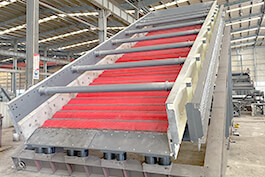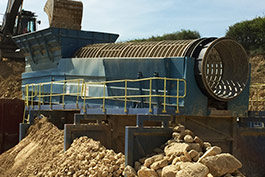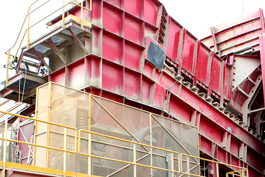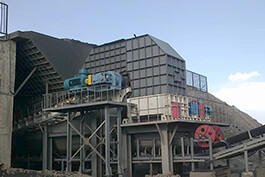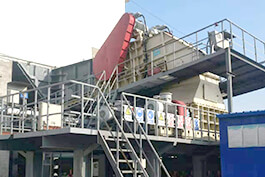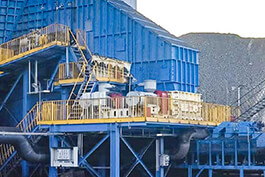Introduce
The existing vibrating screens are driven by an electric motor and consist of an exciter with two axles of unequal weight. The two axles rotate in opposite directions synchronously, generating centrifugal force that causes the screen box to vibrate. The vibration of the screen box then drives the materials on the screen to vibrate, achieving the purpose of sieving. Depending on the relative position of the unbalanced weight on the axles, the trajectory of the screen box's vibration can be either a straight line or an ellipse.
This vibration achieves sieving with large amplitude and high vibration intensity. Especially when the content of damp fine particles in the material is high, the particle size is small, the specific surface area is large, and there are external components such as moisture and clay, the damp fine particles tend to stick together and form clumps, easily adhering to the screen surface and blocking the sieve holes, resulting in poor stability and reliability of the equipment, and the screen frame and other structures are prone to fracture and other accidents. The noise at the equipment site is also high. Large amplitude and high vibration intensity require a high-power motor, which consumes a lot of energy. At the same time, when the material has a relatively high moisture content, sieving is prone to clogging the screen, resulting in low sieving efficiency.
The Flip flow screen can effectively solve the problems of screen blockage and clogging that occur during the sieving process, and is an effective sieving equipment for dry sieving of damp fine particles. Especially in cases where the material is prone to blocking the screen mesh.
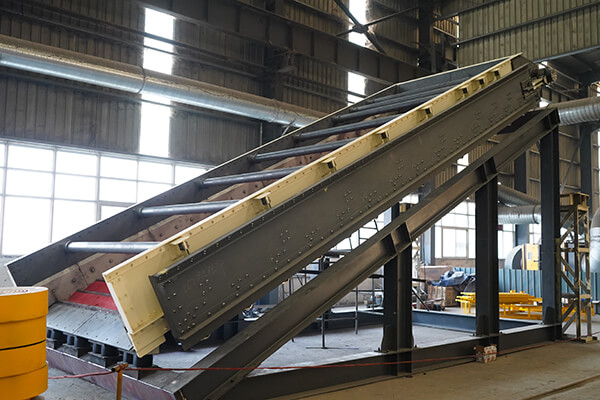
The structure of the Flip flow screen
The structural feature of the Flip flow screen lies in including a main sieve basket. The main sieve basket consists of a left panel and a right panel. There are fixed beams evenly distributed between the left panel and the right panel. Floating beams are set between adjacent fixed beams. The two ends of the floating beams are fixed on the balance pipe, and the balance pipe is connected to the left and right panels through vibration springs. The adjacent fixed beams and floating beams are equipped with sieve plates. The outer walls of the left and right panels are respectively connected to brackets. Eccentric vibration motors are placed on the outer sides of the left and right panels. The two eccentric vibration motors are connected to each other through the main shaft. One of the eccentric vibration motors is connected to the driving device through a universal coupling, and the driving device is installed on the bracket.
The working principle and structural design of the Flip flow screen
Working principle
The working principle of the Flip flow screen is that the eccentric exciter drives the main sieve tube to vibrate, and the main sieve tube, through the resonant spring, causes the balance pipe to drive the floating beam to achieve secondary vibration; the sieve plate can be made of polyurethane, and the polyurethane sieve plate is installed between the fixed beam and the floating beam, thereby causing the polyurethane sieve plate to produce a slackening motion, and the materials on the sieve plate produce a "bouncing effect"; the materials entering the sieve undergo stratification under the slackening motion, and the fine particles are closer to the sieve surface and are easier to pass through the sieve; the agglomerated particles in the material are dispersed under the "bouncing effect" of the sieve plate, and the polyurethane sieve plate has a self-cleaning function; when the external water content is no more than 14%, the raw coal falls onto the sieve surface and, under the slackening action of the sieve plate, due to the material properties of the polyurethane sieve plate itself, the raw coal is effectively bounced and dispersed, and the materials are dispersed to achieve effective sieving.
Structural Design
Beam
The upper parts of the fixed beam and the floating beam of the Flip flow screen are both equipped with sieve plate connection blocks through bolts. The top of the sieve plate connection blocks are provided with slots, and at both ends of the sieve plates, sieve plate legs are set. The sieve plate legs are respectively fixed in the slots. The sieve plate connection blocks can be made of high-hardness polyurethane and fixed to the fixed beam and the floating beam respectively through bolts; the sieve plate legs can be fixed in the slots on the sieve plate connection blocks, and this connection method is convenient for installation and disassembly, and the replacement speed is fast.
Spring
Resonant spring is a rubber shear spring. Spring brackets are set between the outer walls of the left and right plates and the support, and shock-absorbing springs are installed on the spring brackets. Guide springs are evenly distributed between the two plates and the balance pipe. By increasing or decreasing the number of rubber shear springs, the amplitude of the Flip flow screen can be adjusted, which is convenient to use. The vibration of the main sieve basket is buffered by the shock-absorbing springs, reducing the impact on the foundation; the guide springs can be made of an epoxy composite material based on a parallel fine wire structure, with excellent fatigue resistance and high strain capacity, ensuring the correctness of the relative position in the width direction when the fixed crossbeam and the floating crossbeam have a length displacement difference in the flow direction.
Eccentric exciter
The eccentric exciter is composed of two sector-shaped steel plates. Threaded holes are uniformly distributed radially on the sector-shaped steel plates, and the two sector-shaped steel plates are threadingly connected. The two sector-shaped steel plates are connected to the universal coupling. The two sector-shaped steel plates are installed on the universal coupling, and can be installed in a conventional way, which is convenient for installation; by adjusting the relative position of the two sector-shaped steel plates, the magnitude of the excitation force can be adjusted, thereby adjusting the amplitude of the Flip flow screen. When using, according to the screening data and moisture content of the materials, an appropriate amplitude can be selected to ensure a relatively high screening efficiency of the materials.
Dust prevention
A dust prevention bracket is provided on the upper part of the left and right plates. The dust prevention bracket is provided with a dust prevention cover. The dust prevention bracket is fixed on the upper part of the main sieve basket, which can increase the strength of the main sieve basket and be used to support the dust prevention cover.
Conclusion
The Flip flow screen can effectively solve the problems such as clogging and caking of the screen that occur during the material screening process, which leads to low screening efficiency. It is an effective screening equipment for dry screening of damp and fine-grained materials. Especially when the materials being processed are prone to clogging the screen mesh, the Flip flow screen can use a small-power motor to solve the phenomenon of damp materials clustering during the screening process, achieving high screening efficiency with a relatively small screen area and ensuring that the screen mesh does not get clogged.



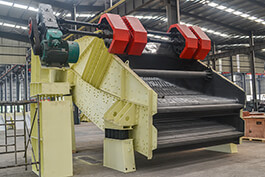
.jpg)
